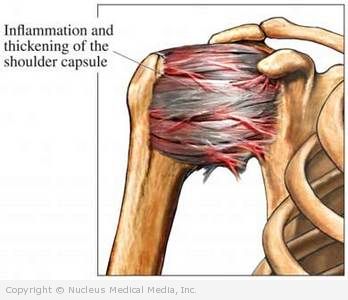Adhesive capsulitis – closed manipulation
(Frozen Shoulder — Closed Manipulation)
Adhesive capsulitis – closed manipulation – Definition
Adhesive capsulitis is a tightening in the shoulder joint. It decreases the range of motion in the shoulder and causes pain. The shoulder does not have full range of motion even when a therapist tries to move the shoulder. This condition is also known as frozen shoulder. It is caused by tightening of the soft tissue and formation of scar tissue.
During closed manipulation, the doctor moves the arm at the shoulder joint. This is done to break up adhesions and loosen the stiff joint. The goal of the procedure is to improve range-of-motion by breaking up scar tissue.
Adhesive capsulitis – closed manipulation – Reasons for Procedure
Your doctor may recommend closed manipulation if other methods of relief have failed. This procedure can relieve pain and stiffness for some patients. In others, there is still some pain and swelling in the shoulder joint. If the closed manipulation is not successful, you may need arthroscopic surgery.
Adhesive capsulitis – closed manipulation – Possible Complications
Complications are rare, but no procedure is completely free of risk. If you are planning to have a shoulder manipulation, your doctor will review a list of possible complications, which may include:
- Pain
- Nerve injury
- Damage to soft tissue
- Instability or stiffness in joint
- Fracture
- Reaction to anesthesia used
Some factors that may increase the risk of complications include:
- Recent or chronic illness
- Certain medicines — especially those that increase bleeding (eg, aspirin)
- Smoking or alcohol use
- Previous shoulder surgery (may cause damage)
Adhesive capsulitis – closed manipulation – What to Expect
Prior to Procedure
Your doctor may do the following:
- Physical exam
- Blood and urine tests
- X-ray — a test that uses radiation to take a picture of structures inside the body, especially bones
- MRI scan — a test that uses magnetic waves to make pictures of structures inside the body
Leading up to the procedure:
- Arrange for a ride to and from the hospital. Also arrange for help at home after the procedure.
- The night before, eat a light meal. Do not eat or drink anything after midnight. If you have diabetes, you may need to adjust your medicines. Ask your doctor about this.
Adhesive capsulitis – closed manipulation – Anesthesia
Your doctor may choose either:
- General anesthesia — You will be asleep during the surgery.
- Local anesthesia (less common) — The shoulder area will be numbed.
Adhesive capsulitis – closed manipulation – Description of the Procedure
The doctor will twist and move your shoulder upward and outward. The actions will break up scar tissue to improve range of motion.
Adhesive capsulitis – closed manipulation – Immediately After Procedure
If you had general anesthesia, the nurses will monitor you in the recovery room.
Adhesive capsulitis – closed manipulation – How Long Will It Take?
45-60 minutes
Adhesive capsulitis – closed manipulation – How Much Will It Hurt?
You will feel no pain during the procedure. You will have soreness after the procedure. The doctor will give you pain medicine.
Adhesive capsulitis – closed manipulation – Average Hospital Stay
Once you recover from the anesthesia, you will be able to go home.
Adhesive capsulitis – closed manipulation – Post-procedure Care
You will have pain and swelling for 1-2 weeks after the surgery. Your doctor may instruct you to:
- Ice the swollen area for the first 24-48 hours. Do this for periods of 20-30 minutes.
- Sleep sitting up or in a recliner. Place a pillow behind your elbow.
- Periodically open and close your hand and move your elbow.
- Begin intense physical therapy.
- Be sure to follow your doctor’s instructions.
Adhesive capsulitis – closed manipulation – Call Your Doctor
After you leave the hospital, contact your doctor if any of the following occurs:
- Cough, trouble breathing, or chest pain
- Severe nausea or vomiting
- Pain becomes worse or swelling increases
- Tingling or numbness that will not go away, especially in arms and hands
In case of an emergency, call for medical help right away.

